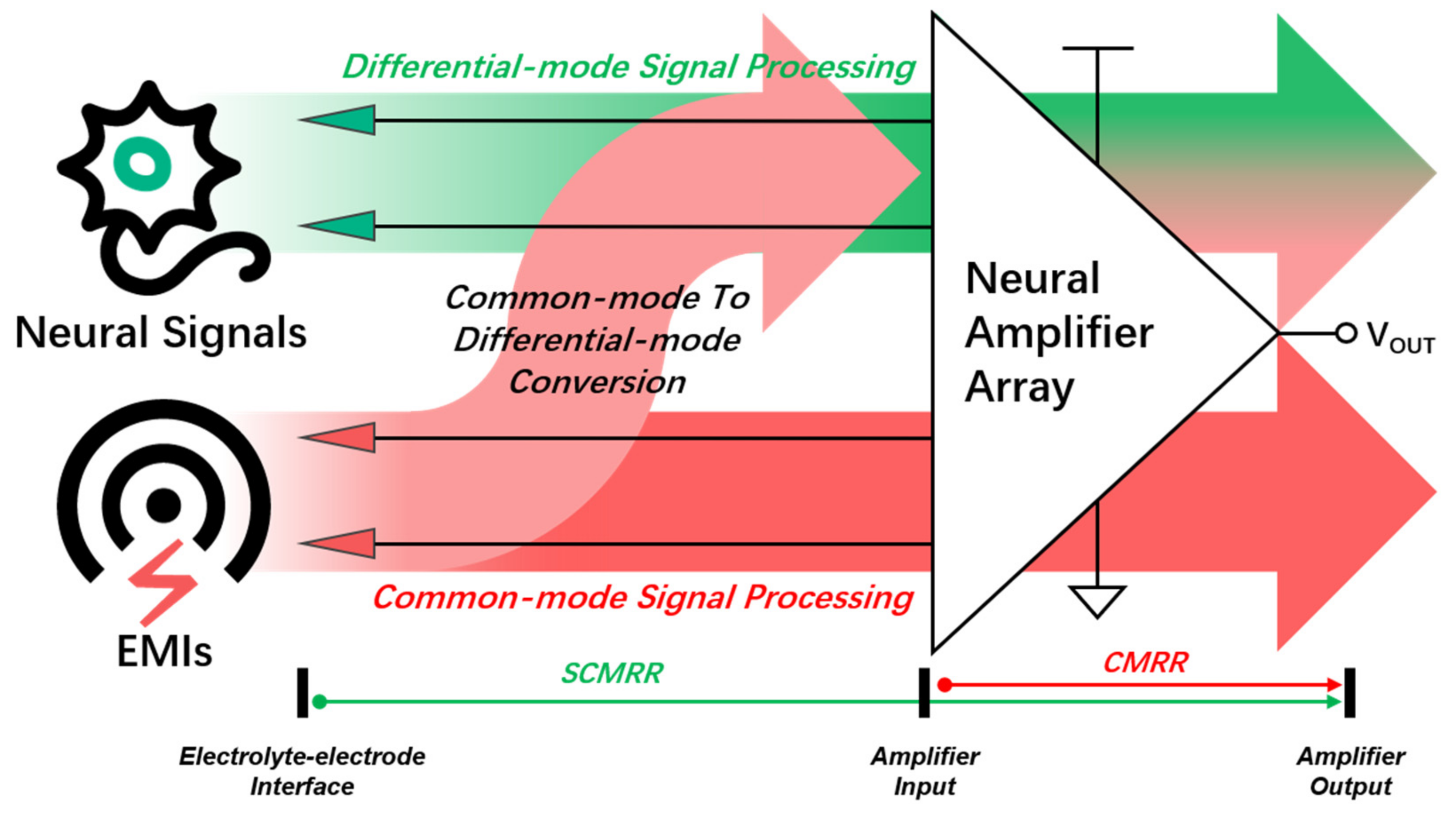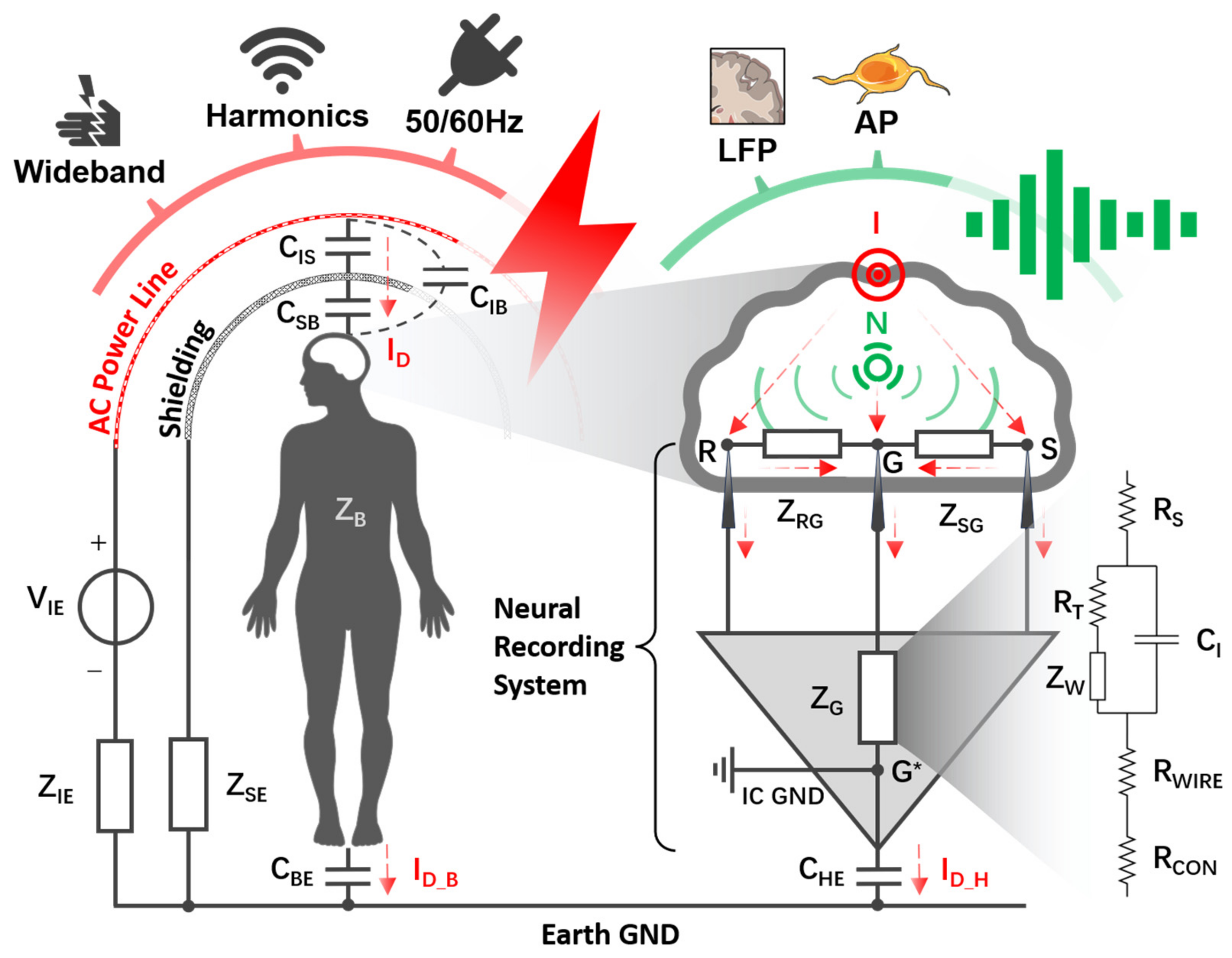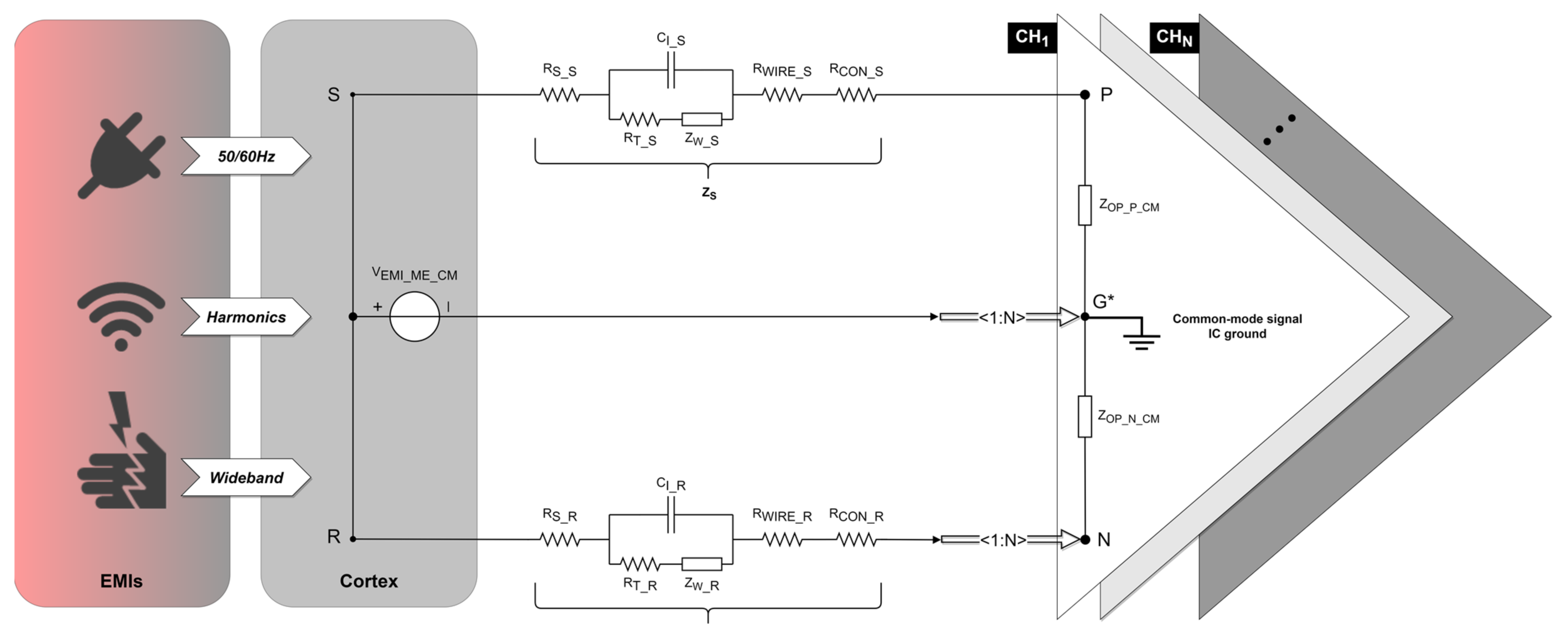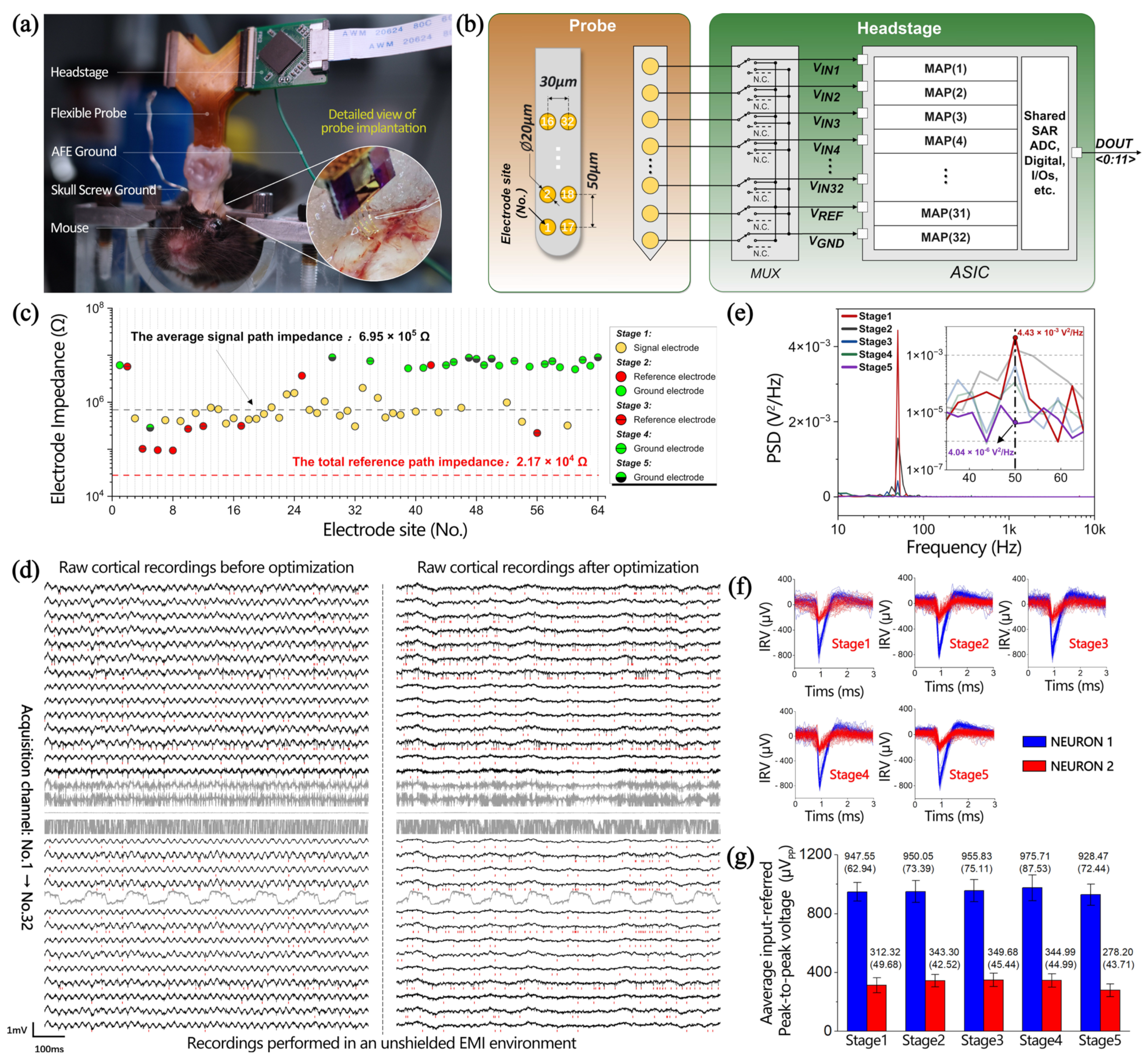Modeling and Analysis of Environmental Electromagnetic Interference in Multiple-Channel Neural Recording Systems for High Common-Mode Interference Rejection Performance
Abstract
:1. Introduction
2. Neural Signals and EMIs from Electrolyte–Electrode Interface
3. Neural Signal Model
4. Common-Mode EMI Model
5. Differential-Mode EMI Model
6. In Vivo Experiments
- (1)
- Maximize the number of ground electrodes implanted in the cortex to reduce the inter-electrode impedance of and/or and the path impedance of , thereby together reducing the introduction of the CMI from the electrolyte–electrode interface.
- (2)
- Optimize the number of reference electrodes implanted in the cortex to achieve impedance matching, thereby avoiding the introduction of DMI due to the potential divider effect.
- (3)
- Place the positions of the signal, reference, and ground electrode in a staggered manner in the cortex to roughly approach the equal trend of and or and , thereby reducing the introduction of DMI from the electrolyte–electrode interface. These optimization strategies are divided into five progressive stages. The raw cortical recording results before and after optimization are displayed in Figure 6d.
7. Conclusions
- (1)
- The space between any two electrodes in the recording, reference, and ground electrode should be >20 µm to avoid accidentally reducing the magnitude of the AP.
- (2)
- On the basis of guideline 1, the space between the signal and reference electrode should be 20–200 µm (minimum LFP local) to meet the different requirements of the magnitude of LFP captured by electrodes and DMI from the electrolyte–electrode interface.
- (3)
- On the basis of guideline 1, place the ground electrode at the midpoint of the signal and reference electrodes in the cortex to alleviate the influence of both CMI and DMI from the electrolyte–electrode interface.
- (4)
- Minimize the path impedance of the ground electrode to reduce the introduction of CMI from the electrolyte–electrode interface and DMI due to the potential divider effect.
- (5)
- On the basis of guideline 4, minimize the path impedance of the signal and reference electrode and maximize the equivalent input differential-mode impedance of OPA to enhance the magnitude of neural signals.
- (6)
- On the basis of guideline 4, match the path impedance of the signal and reference electrode with the equivalent input common-mode impedance of OPA to enhance the common-mode rejection performance of the overall recording system and reduce the introduction of DMI due to the potential divider effect.
Supplementary Materials
Author Contributions
Funding
Institutional Review Board Statement
Informed Consent Statement
Data Availability Statement
Conflicts of Interest
References
- Poo, M.-M.; Du, J.-L.; Ip, N.Y.; Xiong, Z.-Q.; Xu, B.; Tan, T. China Brain Project: Basic Neuroscience, Brain Diseases, and Brain-Inspired Computing. Neuron 2016, 92, 591–596. [Google Scholar] [CrossRef] [PubMed]
- Naddaf, M. Europe spent €600 million to recreate the human brain in a computer. How did it go? Nature 2023, 620, 718–720. [Google Scholar] [CrossRef]
- Ngai, J. BRAIN 2.0: Transforming neuroscience. Cell 2022, 185, 4–8. [Google Scholar] [CrossRef] [PubMed]
- Salahuddin, U.; Gao, P.X. Signal Generation, Acquisition, and Processing in Brain Machine Interfaces: A Unified Review. Front. Neurosci. 2021, 15, 728178. [Google Scholar] [CrossRef] [PubMed]
- Jochum, T.; Denison, T.; Wolf, P. Integrated circuit amplifiers for multi-electrode intracortical recording. J. Neural Eng. 2009, 6, 012001. [Google Scholar] [CrossRef] [PubMed]
- Lopez, C.M.; Andrei, A.; Mitra, S.; Welkenhuysen, M.; Eberle, W.; Bartic, C.; Puers, R.; Yazicioglu, R.F.; Gielen, G.G.E. An Implantable 455-Active-Electrode 52-Channel CMOS Neural Probe. IEEE J. Solid-State Circuits 2014, 49, 248–261. [Google Scholar] [CrossRef]
- Microprobes for Life Science. Array Comparision Chart. Available online: https://www.microprobes.com/support-and-download/array-comparison-chart (accessed on 11 July 2024).
- Prasopsin, P.; Pholpoke, B.; Tepwimonpetkun, S.; Wattanapanitch, W. A compact low-power mixed-signal architecture for powerline interference rejection in biopotential analog front ends. In Proceedings of the 2014 IEEE Biomedical Circuits and Systems Conference (BioCAS) Proceedings, Lausanne, Switzerland, 22–24 October 2014; pp. 196–199. [Google Scholar]
- Tan, B.; Zhang, S.; Gao, C.; Zhou, X.; Li, Q. A 100dB-TCMRR 8-Channel Bio-Potential Front-End with Multi-Channel Common-Mode Replication. In Proceedings of the 2022 IEEE International Symposium on Circuits and Systems (ISCAS), Austin, TX, USA, 27 May–1 June 2022; pp. 2584–2588. [Google Scholar]
- Ng, K.A.; Xu, Y.P. A Low-Power, High CMRR Neural Amplifier System Employing CMOS Inverter-Based OTAs With CMFB Through Supply Rails. IEEE J. Solid-State Circuits 2016, 51, 724–737. [Google Scholar] [CrossRef]
- Wang, Q.; You, C.; Xue, N.; Zhang, X.; Feng, C.; Zhao, Z.; Yao, L.; Li, T. A DC-coupled 1.2 μW 0.012 mm2 per channel neural amplifiers array with 75 dB system common mode rejection ratio and 300 mV common mode interference. Electron. Lett. 2022, 58, 876–878. [Google Scholar] [CrossRef]
- Lopez, C.M.; Putzeys, J.; Raducanu, B.C.; Ballini, M.; Wang, S.; Andrei, A.; Rochus, V.; Vandebriel, R.; Severi, S.; Hoof, C.V.; et al. A Neural Probe With Up to 966 Electrodes and Up to 384 Configurable Channels in 0.13 μm SOI CMOS. IEEE Trans. Biomed. Circuits Syst. 2017, 11, 510–522. [Google Scholar] [CrossRef]
- Angotzi, G.N.; Boi, F.; Lecomte, A.; Miele, E.; Malerba, M.; Zucca, S.; Casile, A.; Berdondini, L. SiNAPS: An implantable active pixel sensor CMOS-probe for simultaneous large-scale neural recordings. Biosens. Bioelectron. 2019, 126, 355–364. [Google Scholar] [CrossRef]
- Koo, N.; Kim, H.; Cho, S. A 43.3-μW Biopotential Amplifier With Tolerance to Common-Mode Interference of 18 Vpp and T-CMRR of 105 dB in 180-nm CMOS. IEEE J. Solid-State Circuits 2023, 58, 508–519. [Google Scholar] [CrossRef]
- Valtierra, J.L.; Fiorelli, R.; Pérez-Prieto, N.; Delgado-Restituto, M.; Rodríguez-Vázquez, Á. A High TCMRR, Inherently Charge Balanced Bidirectional Front-End for Multichannel Closed-Loop Neuromodulation. In Proceedings of the 2019 IEEE Biomedical Circuits and Systems Conference (BioCAS), Nara, Japan, 17–19 October 2019; pp. 1–4. [Google Scholar]
- Thakor, N.V. Translating the Brain-Machine Interface. Sci. Transl. Med. 2013, 5, 210ps17. [Google Scholar] [CrossRef] [PubMed]
- Henze, D.A.; Borhegyi, Z.; Csicsvari, J.; Mamiya, A.; Harris, K.D.; Buzsáki, G. Intracellular features predicted by extracellular recordings in the hippocampus in vivo. J. Neurophysiol. 2000, 84, 390–400. [Google Scholar] [CrossRef] [PubMed]
- Łęski, S.; Lindén, H.; Tetzlaff, T.; Pettersen, K.H.; Einevoll, G.T. Frequency dependence of signal power and spatial reach of the local field potential. PLoS Comput. Biol. 2013, 9, e1003137. [Google Scholar] [CrossRef] [PubMed]
- Spinelli, E.M.; Mayosky, M.A.; Pallás-Areny, R. A practical approach to electrode-skin impedance unbalance measurement. IEEE Trans. Bio-Med. Eng. 2006, 53, 1451–1453. [Google Scholar] [CrossRef] [PubMed]
- Dorr, D. Determining voltage levels of concern for human and animal response to AC current. In Proceedings of the 2009 IEEE Power & Energy Society General Meeting, Calgary, AB, Canada, 26–30 July 2009; pp. 1–6. [Google Scholar]
- Gao, J. Detection of Weak Signals, 3rd ed.; Tsinghua University Press: Beijing, China, 2019. [Google Scholar]
- Massobrio, G.; Martinoia, S.; Massobrio, P. Equivalent Circuit of the Neuro-Electronic Junction for Signal Recordings From Planar and Engulfed Micro-Nano-Electrodes. IEEE Trans. Biomed. Circuits Syst. 2018, 12, 3–12. [Google Scholar] [CrossRef] [PubMed]
- Fang, X.; Collins, S.; Nanivadekar, A.C.; Jantz, M.; Gaunt, R.A.; Capogrosso, M. An Open-source Computational Model of Neurostimulation of the Spinal Pudendo-Vesical Reflex for the Recovery of Bladder Control After Spinal Cord Injury. In Proceedings of the 2022 44th Annual International Conference of the IEEE Engineering in Medicine & Biology Society (EMBC), Glasgow, UK, 11–15 July 2022; pp. 1607–1610. [Google Scholar]
- Zheng, Z.; Mo, F.; Liu, T.; Li, X. A Novel Neuromuscular Head-Neck Model and Its Application on Impact Analysis. IEEE Trans. Neural Syst. Rehabil. Eng. 2021, 29, 1394–1402. [Google Scholar] [CrossRef] [PubMed]
- Popescu, M.; Ravariu, C. Simulation of Spinal Cord Reflexes. Appl. Sci. 2024, 14, 310. [Google Scholar] [CrossRef]
- Lorente de Nó, R. A study of nerve physiology. In Studies from the Rockefeller Institute for Medical Research; Reprints; Rockefeller Institute for Medical Research: New York, NY, USA, 1947; Volume 132, pp. 1–548. [Google Scholar]
- Chen, R.; Canales, A.; Anikeeva, P. Neural recording and modulation technologies. Nat. Rev. Mater. 2017, 2, 16. [Google Scholar] [CrossRef]
- Logothetis, N.K.; Kayser, C.; Oeltermann, A. In vivo measurement of cortical impedance spectrum in monkeys: Implications for signal propagation. Neuron 2007, 55, 809–823. [Google Scholar] [CrossRef]
- Buzsáki, G. Large-scale recording of neuronal ensembles. Nat. Neurosci. 2004, 7, 446–451. [Google Scholar] [CrossRef] [PubMed]
- Ahmadi, N.; Constandinou, T.G.; Bouganis, C.S. Inferring entire spiking activity from local field potentials. Sci. Rep. 2021, 11, 19045. [Google Scholar] [CrossRef] [PubMed]
- Katzner, S.; Nauhaus, I.; Benucci, A.; Bonin, V.; Ringach, D.L.; Carandini, M. Local origin of field potentials in visual cortex. Neuron 2009, 61, 35–41. [Google Scholar] [CrossRef] [PubMed]
- Xing, D.; Yeh, C.-I.; Shapley, R.M. Spatial Spread of the Local Field Potential and its Laminar Variation in Visual Cortex. J. Neurosci. 2009, 29, 11540–11549. [Google Scholar] [CrossRef] [PubMed]
- Berens, P.; Keliris, G.A.; Ecker, A.S.; Logothetis, N.K.; Tolias, A.S. Feature selectivity of the gamma-band of the local field potential in primate primary visual cortex. Front. Neurosci. 2008, 2, 199–207. [Google Scholar] [CrossRef] [PubMed]
- Nauhaus, I.; Busse, L.; Carandini, M.; Ringach, D.L. Stimulus contrast modulates functional connectivity in visual cortex. Nat. Neurosci. 2009, 12, 70–76. [Google Scholar] [CrossRef] [PubMed]
- Wang, C.; Ulbert, I.; Schomer, D.L.; Marinkovic, K.; Halgren, E. Responses of human anterior cingulate cortex microdomains to error detection, conflict monitoring, stimulus-response mapping, familiarity, and orienting. J. Neurosci. Off. J. Soc. Neurosci. 2005, 25, 604–613. [Google Scholar] [CrossRef]
- Kreiman, G.; Hung, C.P.; Kraskov, A.; Quiroga, R.Q.; Poggio, T.; DiCarlo, J.J. Object selectivity of local field potentials and spikes in the macaque inferior temporal cortex. Neuron 2006, 49, 433–445. [Google Scholar] [CrossRef] [PubMed]
- Schroeder, C.E.; Tenke, C.E.; Givre, S.J. Subcortical contributions to the surface-recorded flash-VEP in the awake macaque. Electroencephalogr. Clin. Neurophysiol. 1992, 84, 219–231. [Google Scholar] [CrossRef]
- Majidzadeh, V.; Schmid, A.; Leblebici, Y. Energy Efficient Low-Noise Neural Recording Amplifier with Enhanced Noise Efficiency Factor. IEEE Trans. Biomed. Circuits Syst. 2011, 5, 262–271. [Google Scholar] [CrossRef]
- Chen, C.H.; McCullagh, E.A.; Pun, S.H.; Mak, P.U.; Vai, M.I.; Mak, P.I.; Klug, A.; Lei, T.C. An Integrated Circuit for Simultaneous Extracellular Electrophysiology Recording and Optogenetic Neural Manipulation. IEEE Trans. Biomed. Eng. 2017, 64, 557–568. [Google Scholar] [CrossRef] [PubMed]
- Shahrokhi, F.; Abdelhalim, K.; Serletis, D.; Carlen, P.L.; Genov, R. The 128-Channel Fully Differential Digital Integrated Neural Recording and Stimulation Interface. IEEE Trans. Biomed. Circuits Syst. 2010, 4, 149–161. [Google Scholar] [CrossRef] [PubMed]
- Park, S.Y.; Na, K.; Vöröslakos, M.; Song, H.; Slager, N.; Oh, S.; Seymour, J.; Buzsáki, G.; Yoon, E. A Miniaturized 256-Channel Neural Recording Interface With Area-Efficient Hybrid Integration of Flexible Probes and CMOS Integrated Circuits. IEEE Trans. Biomed. Eng. 2022, 69, 334–346. [Google Scholar] [CrossRef] [PubMed]
- Wang, Q.; Wang, G.; You, C.; Zhang, X.; Liu, D.; Zeng, H.; Xue, N.; Yao, L.; Li, T. An expandable 36-channel neural recording ASIC with modular digital pixel design technique. Electron. Lett. 2023, 59, e12765. [Google Scholar] [CrossRef]
- Leitgeb, N. Assessment of multiple frequency ELF electric and magnetic field exposure. Phys. Med. Biol. 2008, 53, 431–443. [Google Scholar] [CrossRef] [PubMed]
- Stuchly, M.A.; Kavet, R. Numerical modeling of pacemaker interference in the electric-utility environment. IEEE Trans. Device Mater. Reliab. 2005, 5, 481–487. [Google Scholar] [CrossRef]
- Ng, K.A.; Greenwald, E.; Xu, Y.P.; Thakor, N.V. Implantable neurotechnologies: A review of integrated circuit neural amplifiers. Med. Biol. Eng. Comput. 2016, 54, 45–62. [Google Scholar] [CrossRef] [PubMed]
- STAIRMED. Ultra Flexible Micro/Nano Electrodes. Available online: https://www.stairmed.com/ (accessed on 11 July 2024).
- Newman, J. Resistance for Flow of Current to a Disk. J. Electrochem. Soc. 1966, 113, 501. [Google Scholar] [CrossRef]
- Chung, T.; Wang, J.Q.; Wang, J.; Cao, B.; Li, Y.; Pang, S.W. Electrode Modifications to Lower Electrode Impedance and Improve Neural Signal Recording Sensitivity. J. Neural Eng. 2015, 12, 056018. [Google Scholar] [CrossRef]
- Stenger, D.A.; McKenna, T.M. Enabling Technologies for Cultured Neural Networks; Academic Press: Cambridge, MA, USA, 1994. [Google Scholar]
- Guan, S.; Wang, J.; Gu, X.; Zhao, Y.; Hou, R.; Fan, H.; Zou, L.; Gao, L.; Du, M.; Li, C.; et al. Elastocapillary Self-Assembled Neurotassels for Stable Neural Activity Recordings. Sci. Adv. 2019, 5, 11. [Google Scholar] [CrossRef]
- Borkholder, D. Cell Based Biosensors Using Microelectrodes; Stanford University: Stanford, CA, USA, 1998. [Google Scholar]
- Zhou, T.; Yuk, H.; Hu, F.; Wu, J.; Tian, F.; Roh, H.; Shen, Z.; Gu, G.; Xu, J.; Lu, B.; et al. 3d Printable High-Performance Conducting Polymer Hydrogel for All-Hydrogel Bioelectronic Interfaces. Nat. Mater. 2023, 22, 895–902. [Google Scholar] [CrossRef] [PubMed]
- Robinson, D.A. The Electrical Properties of Metal Microelectrodes. Proc. IEEE 1968, 56, 1065–1071. [Google Scholar] [CrossRef]
- Warburg, E. Ueber Das Verhalten Sogenannter Unpolarisirbarer Elektroden Gegen Wechselstrom. Ann. Phys. 1899, 303, 493–499. [Google Scholar] [CrossRef]
- Fontes, M.B.A. Electrodes for Bio-Application: Recording and Stimulation. J. Phys. Conf. Ser. 2013, 421, 012019. [Google Scholar] [CrossRef]
- Obidin, N.; Tasnim, F.; Dagdeviren, C. The Future of Neuroimplantable Devices: A Materials Science and Regulatory Perspective. Adv. Mater. 2020, 32, 26. [Google Scholar] [CrossRef]
- Yang, J.C.; Du, M.D.; Wang, L.; Li, S.X.; Wang, G.R.; Yang, X.L.; Zhang, L.J.; Fang, Y.; Zheng, W.F.; Yang, G.; et al. Bacterial Cellulose as a Supersoft Neural Interfacing Substrate. Acs Appl. Mater. Interfaces 2018, 10, 33049–33059. [Google Scholar] [CrossRef] [PubMed]
- Norlin, P.; Kindlundh, M.; Mouroux, A.; Yoshida, K.; Hofmann, U.G. A 32-Site Neural Recording Probe Fabricated by Drie of Soi Substrates. J. Micromechanics Microengineering 2002, 12, 414–419. [Google Scholar] [CrossRef]
- NEURACOM. Mpk3232a Series. Available online: http://www.neuracom.com.cn/portal/article/index.html?id=108&cid=8 (accessed on 10 June 2024).
- Blanche, T.J.; Spacek, M.A.; Hetke, J.F.; Swindale, N.V. Polytrodes: High-Density Silicon Electrode Arrays for Large-Scale Multiunit Recording. J. Neurophysiol. 2005, 93, 2987–3000. [Google Scholar] [CrossRef]
- TANAKA. Bonding Wires. Available online: https://www.tanaka.com.cn/products/detail/bonding-wires/?nav=use (accessed on 10 June 2024).
- ICM Industrial Development Co., Ltd. Bga Solder Ball: Sn42bi58. Available online: https://www.icmrop.com/uploads/attachment/pdf/20220523/TDS-ICM-Sn42Bi58.pdf (accessed on 10 June 2024).






Disclaimer/Publisher’s Note: The statements, opinions and data contained in all publications are solely those of the individual author(s) and contributor(s) and not of MDPI and/or the editor(s). MDPI and/or the editor(s) disclaim responsibility for any injury to people or property resulting from any ideas, methods, instructions or products referred to in the content. |
© 2024 by the authors. Licensee MDPI, Basel, Switzerland. This article is an open access article distributed under the terms and conditions of the Creative Commons Attribution (CC BY) license (https://creativecommons.org/licenses/by/4.0/).
Share and Cite
Wang, G.; You, C.; Feng, C.; Yao, W.; Zhao, Z.; Xue, N.; Yao, L. Modeling and Analysis of Environmental Electromagnetic Interference in Multiple-Channel Neural Recording Systems for High Common-Mode Interference Rejection Performance. Biosensors 2024, 14, 343. https://doi.org/10.3390/bios14070343
Wang G, You C, Feng C, Yao W, Zhao Z, Xue N, Yao L. Modeling and Analysis of Environmental Electromagnetic Interference in Multiple-Channel Neural Recording Systems for High Common-Mode Interference Rejection Performance. Biosensors. 2024; 14(7):343. https://doi.org/10.3390/bios14070343
Chicago/Turabian StyleWang, Gang, Changhua You, Chengcong Feng, Wenliang Yao, Zhengtuo Zhao, Ning Xue, and Lei Yao. 2024. "Modeling and Analysis of Environmental Electromagnetic Interference in Multiple-Channel Neural Recording Systems for High Common-Mode Interference Rejection Performance" Biosensors 14, no. 7: 343. https://doi.org/10.3390/bios14070343





